Recently updated on July 8th, 2025
Delivering high-impact training at scale has never been more challenging, or more necessary For commercial training providers, clients expect flexible training delivery options, consistent quality, and measurable outcomes – regardless of location or course format.
Many are still piecing things together using off-the-shelf webinar tools, spreadsheets, and inboxes full of registration forms. Sessions get scheduled manually. Presenter links are sent one by one. Follow-ups and certificates often slip through the cracks. The result? Inconsistent delivery, wasted staff time, and a learner experience that feels unpolished.
Virtual Instructor led training software solves these problems by giving you a structured way to run live, remote courses with the same professionalism, consistency and control you’d expect from in-person delivery.
With the right platform, you can automate virtual course scheduling and management, manage registrations, deliver interactive sessions at scale, without relying on generic meeting tools or disjointed systems and workflows.
What is Virtual Instructor-Led Training (VILT)?
Virtual instructor-led training refers to live training sessions delivered online by a real instructor, using tools designed to replicate and improve upon the structure of in-person classroom training.
Unlike traditional instructor-led training (ILT) which takes place in a physical venue, VILT allows instructors and learners to join remotely.
This training format still relies on many of the traits of in-person training for success such as real-time interaction, between instructor to learner, and learner to learner, but with added flexibility through tools like virtual classrooms, breakout rooms, whiteboards and live polls.
VILT is not a replacement for in-person training. Rather, it’s an extension that gives training providers more delivery options, particularly when clients operate across multiple locations or need more accessible formats.
It differs from self-paced elearning, which is asynchronous, and typically completed independently. VILT offers a shared learning environment where instructors guide learners through material, answer questions and facilitate engagement.
How to Choose the Right VILT Software
Not all virtual instructor-led training software is built for the needs of training providers. Many platforms are designed for internal corporate learning or education-first use cases and lack the operational capabilities required to deliver and manage training at scale.
When you’re evaluating VILT software here are the key areas to assess:
Virtual Classroom Experience
Look for software that offers a high quality vietual classroom, ideally with features like breakout rooms, live chat interactive whiteboards, attendance tracking, and participant controls. All of these elements are useful for delivering engaging instructor-led sessions that mirror and build upon the in-person experience.
Scheduling and Registration Management
The right platform should help you run efficient course scheduling and registration workflows The right platform should allow you to set up sessions, assign instructors, publish course pages, and automate confirmation emails and calendar invites.
Platforms like Arlo, for example, combine session scheduling, presenter management, and registration forms into one streamlined workflow.
Support for Blended Learning
If you deliver training across multiple formats – virtual, in-person, or elearning, you’ll need a platform that supports blended learning paths.
In practice- this means features that allow you to set up courses that include a mixture of live sessions, or self paced modules, or live sessions with self-paced content or assessments.
Reporting and Analytics
You’ll need visibility into attendance, completion rates, and be able to create reports on these metrics to share with stakeholders. If you’re selling courses then ideally the platform has ecommerce features, and gives you insights into financial metrics such as how much revenue, a single or set of courses has brought in, and profit/loss breakdowns.
Top Virtual Instructor-Led Training Software
We’ve compiled a list of the top virtual instructor-led training software to help you find the perfect fit for your organization. Keep reading for detailed descriptions of each option.
| Platform | Best For | Key Features | Pricing Tier | Free Trial |
|---|---|---|---|---|
| Arlo | Commercial training providers | Course scheduling, Zoom integration, registration management, AI course builder | Mid-market | ✅ |
| ReadyTech | Technical training and virtual labs | Lab control, instructor dashboards, co-browsing, help queues | Enterprise | ✅ |
| LearnCube | Tutoring and small-group instruction | Interactive whiteboard, real-time collaboration, virtual classroom tools | Entry–Mid | ✅ |
| TalentLMS | Blended and gamified learning | SCORM support, gamification, reporting, Zoom/MS Teams integration | Mid-market | ✅ |
| Docebo | Enterprise LMS with live training support | AI content, blended learning, LMS integrations, analytics | Enterprise | ✅ |
| WorkRamp | Customer and employee onboarding | Branded portals, Zoom integration, flexible content delivery | Enterprise | ✅ |
| Adobe Connect | Structured, data-rich virtual classrooms | Custom layouts, engagement dashboards, breakout rooms | Enterprise | ✅ |
| BigBlueButton | Open-source, LMS-integrated VILT | Whiteboards, breakout rooms, LMS integrations (Moodle, Canvas) | Open-source | ❌ |
| WizIQ | Branded corporate learning environments | Virtual classrooms, course authoring, mobile access | Varies | ✅ |
| Cypher Learning | Academic and blended learning | Lesson planning, automation, collaborative learning tools | Enterprise | ✅ |
1. Arlo Training Management Software
Arlo is an all-in-one training management platform purpose-built for commercial training providers. It supports virtual instructor-led training, alongside in-person and self-paced formats, giving providers the flexibility to run any course deliver model from one place.
Arlo is built around the operational realities of running scheduled training: live delivery, course logistics, instructor coordination, registrations and reporting.
Whether you’re delivering a virtual session to five learners or managing a multi-region program with multiple presenters, Arlo gives you the tools to scale without losing control.
Key VILT and Blended Learning Features within Arlo
Virtual Classroom Integration
Manage all aspects of your live, instructor-led sessions directly within Arlo. You can schedule sessions, assign multiple presenters or support staff, and automatically send calendar invites and personalized join links to each registrant. Arlo integrates seamlessly with Zoom, allowing you to run interactive virtual classrooms while keeping all sessions logistics in one place.

Automated Registration and Communication
Arlo’s training registration software handles the course registration process from start to finish. Set up branded registration pages with flexible forms for fee or paid sessions. Once someone registers, Arlo automatically send confirmation emails, calendar invites, payment receipts (if applicable_) and reminders, so you don’t need to manually follow up.

Instructor and session management
Assign presenters to specific sessions, manage availability across time zones, and coordinate session materials and responsibilities. Arlo gives you full visibility over session schedules, and lets you streamline internal communication between your delivery teams and operational staff.
Attendance tracking and post-course engagement
Capture live attendance and participation data for each session. After the session, Arlo can automatically send follow-up emails, course surveys, and completion certificates. These features help learners et a professional experience and helps you meet compliance or accreditation requirements.

Blended and self-paced delivery support
Design courses that combine live sessions with elearning modules, microlearning content, or on demand videos.
You can sequence learning paths to include virtual classes, pre-work, assessments and follow-ups. This helps you deliver flexible training programs that accommodate different learner needs and delivery models.
AI-powered eLearning authoring
Convert Word, Powerpoint, or PDF content into structured elearning modules directly within Arlo, or use Arlo’s built in AI assistant to generate new course content based on your inputs, customizing tone, visuals and layout to match your brand and delivery style.
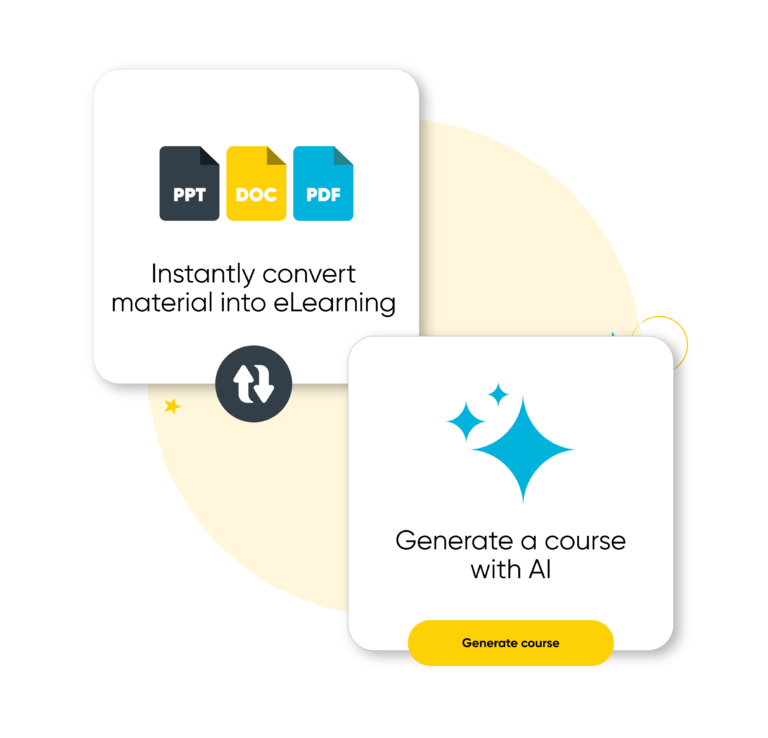
Website publishing and course sales
Publish upcoming virtual, in-person or blended courses to your public-facing website with detailed schedules, pricing, and session breakdowns. Arlo’s ecommerce tools allow you to accept online payments, offer discounts an manage group bookings without requiring third party tools.
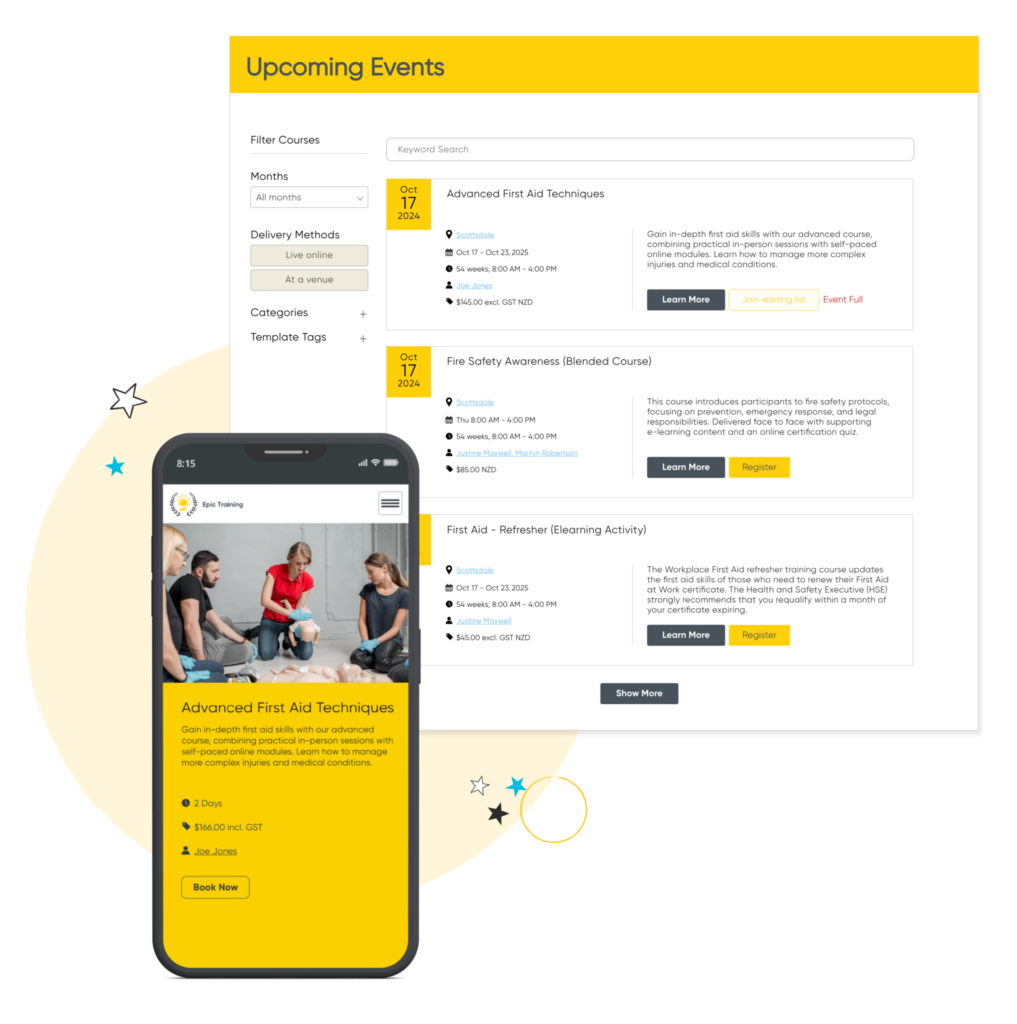
Real-time reporting and performance dashboards
Track registrations, attendance, revenue and course completion from a single dashboard. You can create custom reports, schedule automated updates for internal teams or clients, and monitor key metrics like fill rates and learner progress over time.

What These Features Mean for Training Providers
All of these features within Arlo are purpose built for training companies. The platforms disjointed tools like webinar platforms, spreadsheets and manual email processes with integrated features that handle scheduling, registrations, session delivery, and post course follow-up.
For training providers, this means:
- Greater efficiency in managing training sessions, presenters, and participant communication
- A smoother learning experience, with automated updates, reminders, and certificates
- Consistent delivery standards across formats, teams and locations
- Clear visibility into performance, with reporting on registrations, attendance, revenue and engagement
- The ability to scale training programs whether delivering live virtual training sessions, blended courses, or on demand content
Arlo gives training providers the structure and flexibility to run professional, high-volume training operations, without the overhead of managing it all manually.
Try Arlo for free.
2. Absorb LMS

Absorb LMS supports virtual instructor-led training (VILT) as part of its broader functionality. While its primary focus is on self-paced e-learning, it provides tools to manage live training sessions, although these are not as specialized as those offered by platforms dedicated to ILT.
Key Features
Session Scheduling and Management
The platform includes features for scheduling and organizing ILT sessions, whether they take place in physical or virtual venues. These tools allow administrators to set up recurring sessions and manage logistics.
Attendance Tracking
Absorb LMS tracks attendance for ILT sessions, enabling organizations to monitor participation and maintain compliance records.
Reporting and Analytics
The platform offers standard reporting capabilities, which include insights into session attendance and learner performance. These reports can assist organizations in evaluating the effectiveness of their VILT programs.
Resource Allocation
Basic tools for managing resources such as training materials, equipment, and virtual meeting links are included, but these are not as robust as platforms specifically designed for ILT.
Limitations for ILT-Focused Organizations
While Absorb LMS can support ILT, it lacks features like integrated e-commerce, course marketing tools, and advanced website integrations. This may limit its suitability for organizations primarily running ILT or VILT programs.
Pricing
Talent LMS has four plans available:
Enterprise: Contact company.
Core: $119/month
Grow: $299/month
Pro: $399/month
3. Cypher Learning

CYPHER Learning is a learning management system built with educational institutions in mind. While it supports virtual instructor-led training (VILT) alongside other formats, its design prioritizes classroom teaching and collaborative learning over specialized tools for corporate training or ILT-focused organizations.
Key Features
Centralized Resource Management
CYPHER consolidates teaching materials, lesson plans, multimedia resources, and assessments into one system, simplifying the preparation and delivery of virtual or hybrid sessions.
Flexible Session Scheduling
The platform supports scheduling and managing in-person, virtual, or hybrid classes, with tools that allow adjustments based on the requirements of learners and instructors.
Automation of Administrative Tasks
Key administrative processes like attendance tracking, grading, and notifications are automated, reducing manual workload and allowing instructors to focus on delivering effective sessions.
Pricing
Pricing isn’t public. Contact the provider for a quote.

4. Gyrus Learning Platform

GyrusAim is a learning management system (LMS) designed to handle the specific needs of instructor-led training (ILT) programs. It provides tools to schedule, manage, and document training sessions, focusing on practical functionality for compliance-heavy industries.
Key Features
ILT Scheduling
Supports the organization of training sessions by allowing users to assign instructors, set up locations, and establish schedules, accommodating recurring and one-time training needs.
Resource Management
Includes tools for allocating necessary resources such as equipment, materials, and venues, ensuring sessions are fully supported.
Attendance Tracking
Offers straightforward options for recording and monitoring attendance, which is particularly useful for compliance and performance assessments.
Training Records
Provides a centralized system for maintaining participant records, including completed training, certifications, and ongoing progress, simplifying auditing and reporting requirements.
Pricing
Plans start at $5,500 per year.
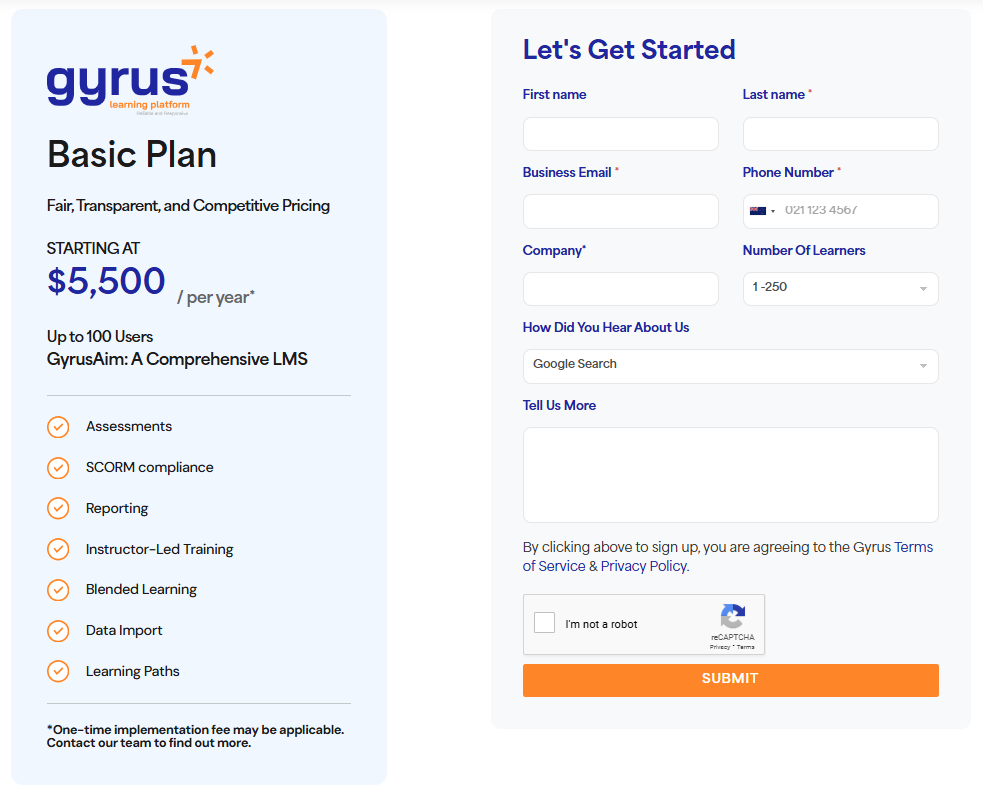
5. WorkRamp

WorkRamp offers tools for organizations to manage live virtual training alongside other learning formats. Its features are designed to support both employee and customer education through integrations, tracking, and flexible delivery options.
Key Features
Integration with Conferencing Tools
WorkRamp integrates with platforms like Zoom for easy management of virtual sessions. Instructors can schedule sessions, generate meeting links, and store course recordings for on-demand access.
Attendance and Participation Tracking
The platform tracks attendance and engagement during virtual training sessions. This includes features for managing waiting lists and tying attendance data to overall training performance.
Support for Blended Learning
WorkRamp combines virtual instructor-led training with self-paced e-learning and interactive content.
Customizable Training Portals
Organizations can create branded portals for learners, providing a centralized location for accessing training materials and attending virtual sessions.
Reporting Tools
WorkRamp includes analytics to measure the success of virtual training sessions, providing data on learner participation, session effectiveness, and completion rates.
Pricing
WorkRamp has five plans available, but pricing for each of them is not public.

6. TalentLMS

TalentLMS is a learning management system (LMS) designed to handle both online and offline training. It supports blended learning with options for self-paced courses, live virtual sessions, and in-person classes.
Key Features
Blended Learning Support
Offers self-paced courses, live virtual sessions, and in-person training in one system.
Instructor-Led Training (ILT) Management
Enables scheduling of recurring ILT sessions, linking them to online courses, and self-registration for learners.
Video Conferencing Integration
Integrates with Zoom, Microsoft Teams, and GoToMeeting for virtual lessons.
Administrative Automation
Handles session reminders, graded session notifications, and instructor alerts for new learners.
Pricing
Talent LMS has four plans available:
- Core: $119/month
- Grow: $299/month
- Pro: $399/month
- Enterprise: Contact company.

7. Docebo

Docebo is a learning management system that includes features for virtual instructor-led training (VILT) as part of its broader functionality. While its primary focus is on managing various types of learning content, Docebo provides tools to schedule and run live sessions alongside self-paced learning materials.
Key Features
Virtual Classroom Integrations
Docebo supports live training through integrations with platforms like Zoom, Microsoft Teams, and Webex, allowing users to schedule and manage sessions directly within the LMS.
Supports Blended Learning
Instructors can combine live virtual sessions with pre-recorded courses and other learning materials to create flexible training programs tailored to different learning needs.
Tracking and Reporting
The platform provides basic tracking features for attendance and learner participation during live sessions, alongside detailed analytics for course performance.
Mobile Access
With a dedicated mobile app, learners can join live sessions or access training materials from anywhere, making participation more convenient.
Pricing
Pricing isn’t publicly stated, contact the company for a quote.
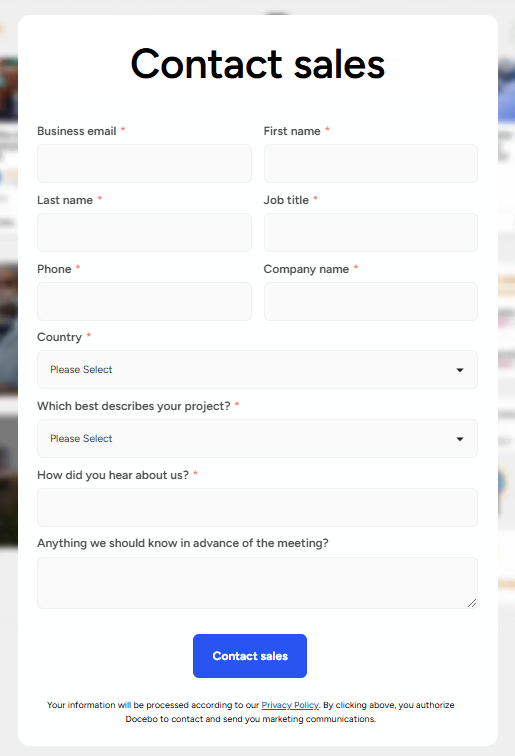
8. LearnCube
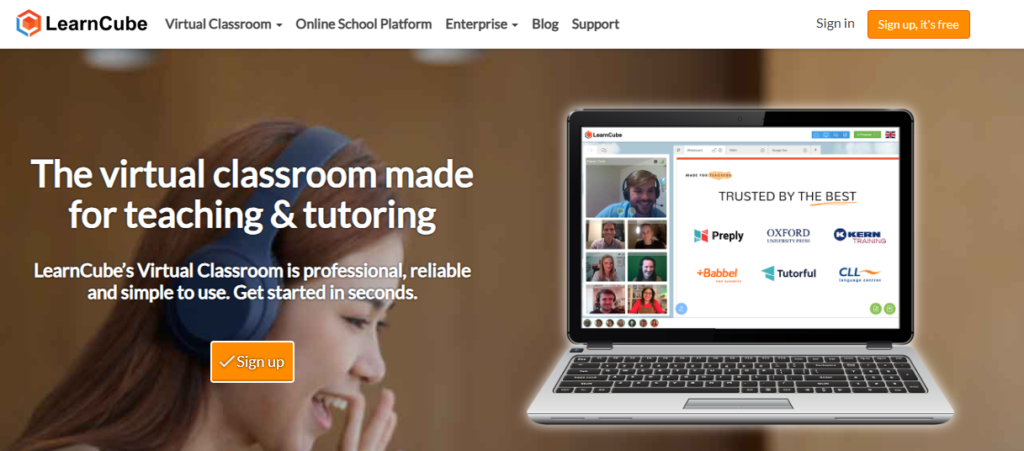
LearnCube is an online learning platform designed specifically for virtual instructor-led training (VILT). It offers a dedicated virtual classroom environment with tools tailored for live, interactive teaching.
The platform works well tutoring, corporate training, and group classes.
Key Features
Virtual Classroom Environment
A dedicated space designed for live teaching, equipped with features like an interactive whiteboard and real-time collaboration tools.
Reliable Connectivity Tools
Optimized video and audio functionality to maintain consistent quality, even with slower internet connections.
Interactive Whiteboard
Enables instructors and learners to collaborate visually with drawing tools, annotations, and shared screens.
Built-In Communication Tools
Includes live text chat, optimized conversation modes, and tools for interactive language or writing exercises.
Flexible Class Management
Supports multiple teaching formats, including one-on-one sessions and small group classes (up to eight participants).
Pricing
LearnCube has four pricing plans:
- Virtual Classroom Basic – Free
- Virtual Classroom Pro – from $19 per month
- Online School Premium – from $99 per month
- Enterprise – available upon request.
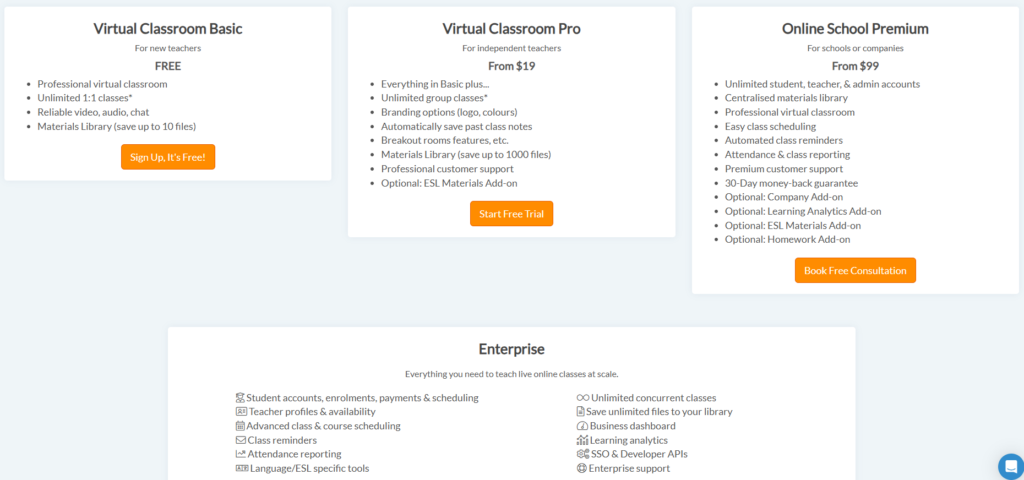
9. BigBlueButton
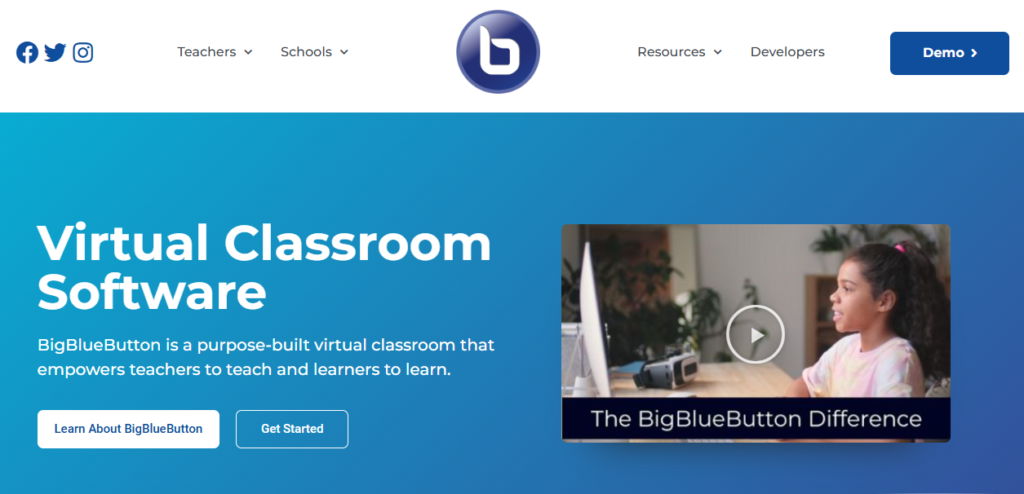
BigBlueButton provides a range of tools specifically developed for instructor-led virtual training, with a focus on interactivity and security. Its open-source framework allows organizations to tailor the platform to their needs while integrating seamlessly with existing learning systems.
LMS Integration for Simplified Management
BigBlueButton integrates directly with learning management systems like Moodle and Canvas, allowing instructors to manage virtual classes, assignments, and schedules within a single platform.
Multi-User Whiteboard and Collaboration Tools
The interactive whiteboard enables instructors and learners to annotate and collaborate in real time, supporting hands-on exercises and visual demonstrations during lessons.
Breakout Rooms for Group Activities
Breakout rooms provide opportunities for smaller group discussions or focused tasks, making the platform ideal for project-based learning or corporate training scenarios.
Real-Time Analytics and Tracking
Analytics features allow instructors to track attendance, engagement, and participation levels, helping to identify and address disengaged learners.
Security and User Authentication
Strong authentication measures prevent unauthorized access, making BigBlueButton a secure choice for organizations concerned with protecting their virtual classroom environment.
Open-Source Customization
Organizations can modify the platform to meet their specific needs, whether by adding integrations, customizing the user interface, or implementing institution-specific features.
Pricing
Pricing not publicly stated on website.
10. WizIQ
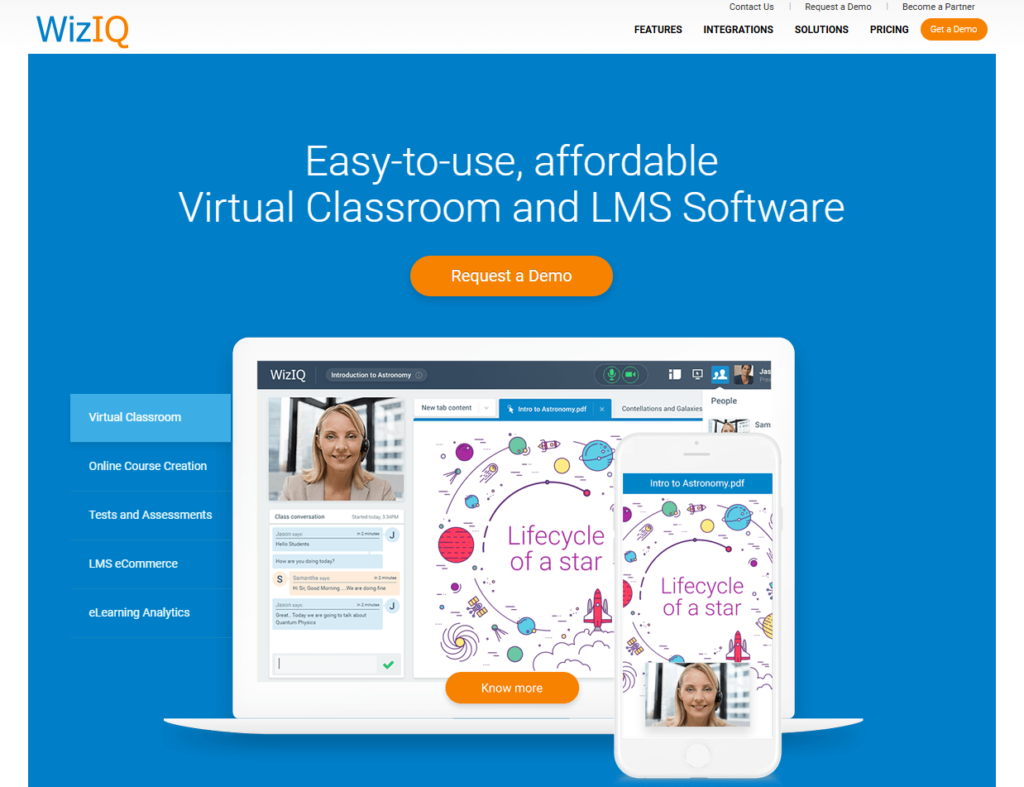
WizIQ focuses on delivering tools for live, instructor-led training sessions while also supporting course creation and large-scale online education initiatives.
Its capabilities extend to creating branded portals, managing large learner groups, and enabling mobile-friendly learning, making it versatile for various industries, including corporate training, test preparation, and higher education.
Key Features
Virtual Classroom Tools
Includes features such as live video and audio streaming, screen sharing, and interactive tools like a digital whiteboard to facilitate real-time engagement during training sessions.
Course Development and Delivery
Enables trainers to design courses with multimedia content, quizzes, and assessments, supporting self-paced and instructor-led learning models.
Mobile-Friendly Learning
Offers dedicated mobile apps for Android and iOS, ensuring learners can participate in training sessions or access materials from any location.
Customizable Learning Portals
Provides options to build branded portals for employee training, customer education, or partner onboarding, aligning with organizational branding and identity.
Pricing
WizIQ has three pricing plans available for their virtual classroom software: Professional, Enterprise and Pay-per-use. You have to contact them for pricing for each plan.
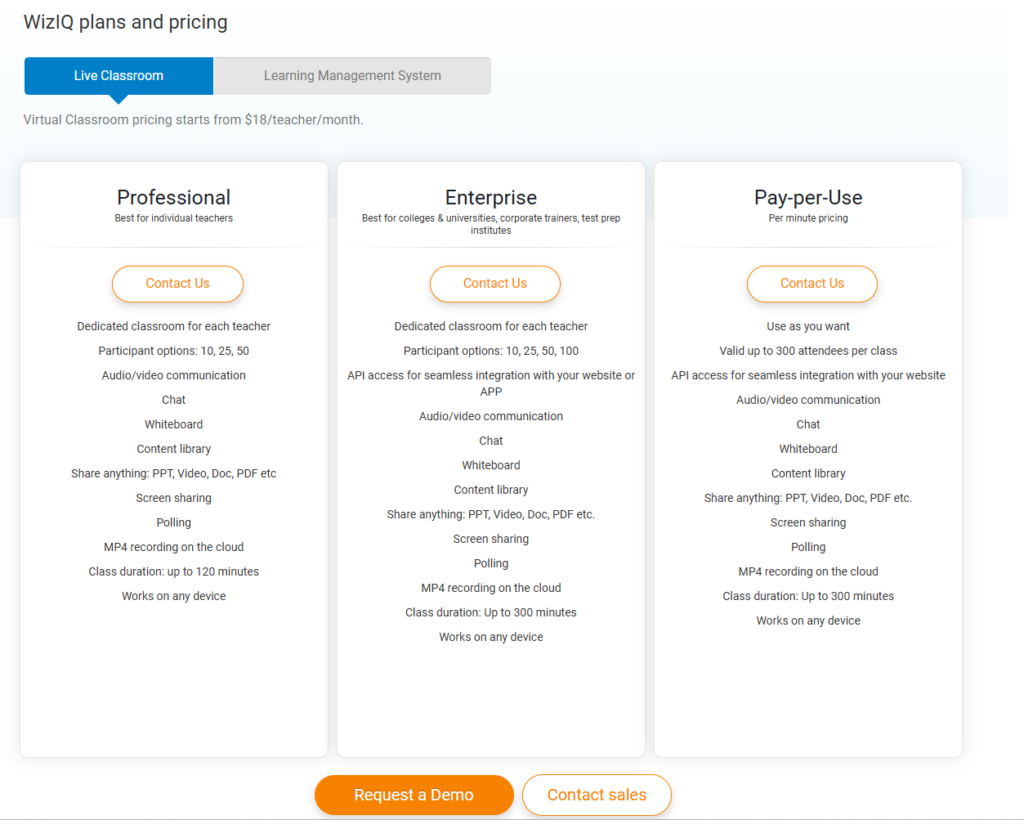
Other Features to Look Out for in a Virtual-Instructor Led Training Platform
Efficient Course Scheduling
Look for software that makes it easy to set up and schedule your virtual sessions. Ideally, you should be able to do this through a single workflow.
Within Arlo, for example, you can choose the type of course you’re setting up, e.g., a live virtual course or blended course, set up all of your important course information (time, date, course info, etc.), schedule the course on your website to accept bookings, and set up presenter links for the video delivery platform you are using, e.g., Zoom.
Each registrant will receive the relevant links upon successfully registering for a course, alongside individualized join instructions, a calendar appointment, reminders, follow-up emails, and surveys (if enabled).
Interactive Features and Engagement Tools
The platform should have interactive features like live polls, chat functions, and breakout rooms to keep participants engaged during sessions. These should either be native to the platform or available through integrations.
Arlo, for example, integrates with Zoom, and through Zoom, you get access to breakout rooms, live polls, virtual whiteboards, and more. Arlo’s upcoming eLearning authoring features will also enable you to create quizzes, flashcards, videos, checklists, slide shows, and more that you can use to improve the interactivity of your training.
Scalability for Remote Learning
The platform you choose should be able to handle a large number of registrants, as this is crucial depending on the size of your training business.
Platforms like Arlo, for instance and the other large LMS platforms we’ve spoken about (Docebo, Absorb LMS etc), are built to manage high volumes of registrations and attendees efficiently.
Arlo’s integration with video delivery platforms like Zoom supports scaling up virtual sessions, while automated processes like registration handling, reminders, and follow-ups help streamline operations as your business and registration numbers grow.
Ready to Take the #1 VILT Platform for a Spin?
Of course, you shouldn’t just take our word for Arlo being the #1 VILT and training management platform. You can take a free trial of Arlo to test its capabilities for yourself and see how our platform can help you create, schedule, and deliver in-person, virtual, blended, and eLearning training.
Get started today 👇
